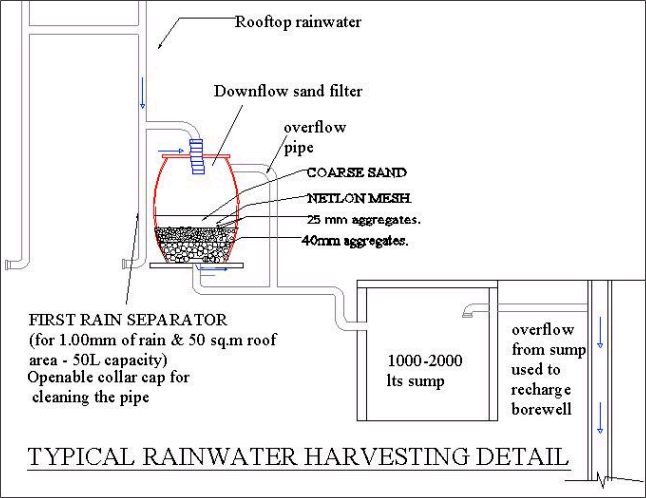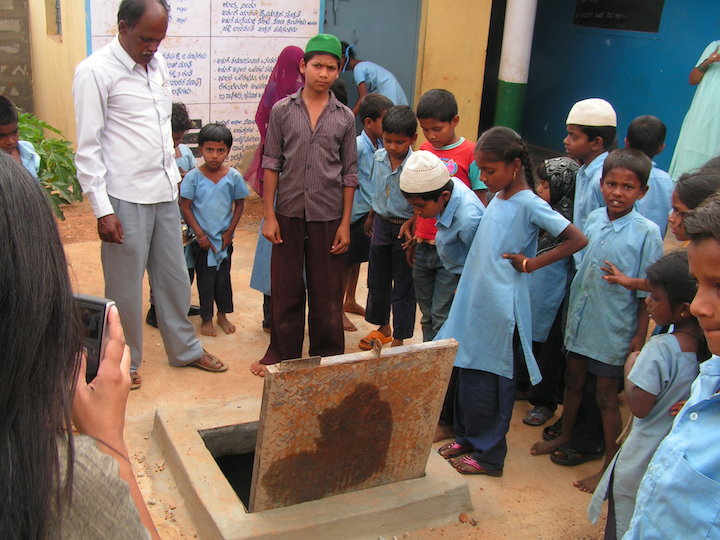Difference between revisions of "Sump tank"
(→Construction, operation and maintenance) |
|||
| (21 intermediate revisions by the same user not shown) | |||
| Line 1: | Line 1: | ||
[[Image:sump storage tank.jpg|thumb|right|200px|A sump tank under construction – Every building in Bangalore has one. Source: [http://rainwaterharvesting.wordpress.com/2013/10/31/on-the-sump-tanks-of-bangalore/ On the sump tanks of Bangalore]]] | [[Image:sump storage tank.jpg|thumb|right|200px|A sump tank under construction – Every building in Bangalore has one. Source: [http://rainwaterharvesting.wordpress.com/2013/10/31/on-the-sump-tanks-of-bangalore/ On the sump tanks of Bangalore]]] | ||
| + | [[Image:sump tank 2.jpg|thumb|right|200px|Source: [http://www.rainwaterharvesting.org/Urban/Components.htm rainwaterharvesting.org]]] | ||
| + | |||
| + | A sump is an underground (or partially underground) tank that is popular in India. It is usually used for large water tank storage and can be built cheaply using cement-like materials. It is usually part of a rainwater harvesting system, where the rainwater gets channeled into the tank, then pumped out for use. | ||
| + | |||
| + | ===Suitable conditions=== | ||
| + | The ground should not be rocky close to the surface, which can hinder the digging and construction process. Secondly the groundwater table in the area should not be very high and should ideally be several metres below the bottom of the tank. Underground sump tanks must not be built very close to underground sewerage chambers or lines trees like the coconut which have strong roots that spread widely existing foundations, especially those that may not be very deep waste water treatment systems. | ||
| + | |||
| + | |||
| + | {| border="1" cellpadding="5" cellspacing="0" width="70%" | ||
| + | |- | ||
| + | ! width="50%" style="background:#efefef;" | Advantages | ||
| + | ! style="background:#f0f8ff;" | Disadvantages | ||
| + | |- | ||
| + | | valign="top" | - Generally cheaper than above ground storage tanks <br> | ||
| + | - Water cannot leak out through an open tap <br> | ||
| + | - Does not affect the aesthetics of the building and the space above the tank can be utilized for other purposes <br> | ||
| + | - Most suited for large volume storage tanks (10,000 litres and above)<br> | ||
| + | | valign="top" | - Construction is time consuming<br> | ||
| + | - Can affect the foundation of the building if constructed very close to the building<br> | ||
| + | - Pumping system required to take out the water<br> | ||
| + | - Not easy to detect or repair leaks <br> | ||
| + | - Cannot be drained easily and hence cleaning is a problem<br> | ||
| + | - More prone to contamination<br> | ||
| + | - If the tank or manhole is left uncovered, it can be a safety hazard <br> | ||
| + | - The tank can be damaged by tree roots<br> | ||
| + | - If not constructed properly, the pressure exerted by the Earth can also cause damage to the tank <br> | ||
| + | - Heavy vehicles cannot be driven over the tank, since the exerted pressures can cause damage | ||
| + | |} | ||
| + | |||
| + | |||
| + | ===Construction, operation and maintenance=== | ||
| + | [[Image:sump tank 3.jpg|thumb|right|200px|A 20,000 litre sump tank collects rainwater. Source: [http://rainwaterharvesting.wordpress.com/2011/06/21/hi-tech-vs-low-tech-in-the-water-sector/ Hi-Tech vs Low-tech in the rural drinking water sector]. June 21, 2011]] | ||
| + | [[Image:sump tank 4.png|thumb|right|200px|For those who have connected the rooftop to sumps, it is time to clean up the roof, pipes and filters and the sump itself and be ready to collect the bounty. Source: [http://www.indiawaterportal.org/news/preparing-monsoons-mazhapolima-way-kerala-simple-rooftop-rainwater-harvesting-and-aquifer Preparing for the monsoons the 'Mazhapolima' way in Kerala: Simple rooftop rainwater harvesting and aquifer recharge]]] | ||
| + | * The overflow pipe should be just below the tank / sump cover so that there is no ‘dead space’ and the tank can be used to its maximum capacity. The overflow pipe should divert the excess water away from the sump and the foundations of other buildings and structures. This water should be directed to gardens or into the storm water drain and should not create slushy areas. A reverse U bend should be installed at the end of the overflow pipe so that light and other impurities do not enter the tank. | ||
| + | |||
| + | * Water should be extracted from the tank / sump only by means of a tap or pump. Taps or draw off pipes should not be very close to the bottom of the tank, since there is likelihood of sedimentation and the dirt should be allowed to settle and remain in the tank until cleaned. If the dirt enters the water outlet pipe and the plumbing network it can cause blockages. | ||
| + | |||
| + | * Sumps could have level indicators, so that the pumps don’t run dry. Level indicators can be as simple as a dip-stick or can be electronic. Dip-stick systems have the disadvantage of being a conduit for light and impurities to enter the storage tank | ||
| + | |||
| + | * '''How large should the sump be?''' Even a small storage system can generate large collection provided we use the rainwater every time it rains. In Bangalore for example, with it’s evenly spread rains, a 500 litre sump tank can generate 25,000 litres of rainwater in a year. An ideal size is 2000 litres of sump storage for 100 square metre of roof area. This is as per the building bye law for Bangalore. 6000 litres of storage for 100 square metre roof area should give you 70,000 litres of water in a well distributed rainfall year<ref> S.Vishwanath</ref>. | ||
| + | |||
| + | * Cylindrical ferrocement or Reinforced Cement Concrete (RCC) recommended as tank building material. Plastic or brick is not recommended. | ||
| + | |||
| + | * A first rain separator is crucial to the collection of clean rainwater in sump tanks<ref> S.Vishwanath</ref>. | ||
| + | |||
| + | |||
| + | [[Image: sump setup.png|thumb|none|500px|Source: unknown]] | ||
===Bangalore example=== | ===Bangalore example=== | ||
| + | [[Image:RWH-children-with-the-rainwater-storage-sump.jpg|thumb|right|200px|Source: [http://www.thebetterindia.com/6570/the-honeycomb-effect-small-causes-small-changes-big-impact-part-1/#sthash.KEq2V0Xu.dpuf The Honeycomb Effect: Small Causes, Small Changes – Big Impact (Part1)]]] | ||
In Bangalore, water will be purchased from private water tankers and stored to be used for construction. One estimate says there a million sumps in the city alone with an average capacity of 6000 litres. This means that the water storage capacity created is a staggering 6000 million litres. Remember that the city gets in about 1000 million litres every day. Added to the fact that there is about 1000 million litres stored in overhead tanks the water storage by the city far outstrips that created by the utility. | In Bangalore, water will be purchased from private water tankers and stored to be used for construction. One estimate says there a million sumps in the city alone with an average capacity of 6000 litres. This means that the water storage capacity created is a staggering 6000 million litres. Remember that the city gets in about 1000 million litres every day. Added to the fact that there is about 1000 million litres stored in overhead tanks the water storage by the city far outstrips that created by the utility. | ||
| Line 23: | Line 71: | ||
Even though hidden from view the sump tank has an important role to play in the use of a building. A good design and maintenance will help extend its life and for it to perform optimally. In this understanding lies water wisdom. | Even though hidden from view the sump tank has an important role to play in the use of a building. A good design and maintenance will help extend its life and for it to perform optimally. In this understanding lies water wisdom. | ||
| + | The ideal system in Bangalore is one where rainwater is stored in sumps and the surplus used for recharging borewells. | ||
| + | |||
| + | ===Field experiences=== | ||
| + | {|style="border: 2px solid #e0e0e0; width: 20%; text-align: justify; background-color: #e9f5fd;" cellpadding="2" | ||
| + | |- style="vertical-align: top" | ||
| + | |[[Image:akvorsr logo_lite.png|center|60px|link=http://akvo.org/products/rsr/]] | ||
| + | |- style="vertical-align: bottom" | ||
| + | |[[Image:RSR project 282 - sump tank.jpg |thumb|center|140px|<font size="2"><center>[http://rsr.akvo.org/project/282/ RSR Project 282]<br>Rainwater harvesting for Vijayapura schools</center></font>|link=http://rsr.akvo.org/project/282/]] | ||
| + | |} | ||
| + | |||
| + | <br> | ||
| + | ===Costs=== | ||
| + | A tanker load (in Bangalore) of 6000 litres costing about Rs 200/-. To store water during construction, sumps were built and these would also be 6000 litres so as to fill up a tanker load completely. Coincidentally this happened to be the exact optimal storage requirement for rainwater harvesting. This made it easier for implementation using the sump as storage<ref>[http://www.rainwaterclub.org/docs/Domestic_Rainwater_Harvesting.pdf Domestic Rainwater Harvesting, Some applications in Bangalore, India]</ref>. | ||
===Manuals, videos and links=== | ===Manuals, videos and links=== | ||
{{#ev:youtube|O-2dEifj5Ac|200|auto|<center><font size="3">Harvesting rain - an urban rainwater system, Bangalore, India.</font></center>}} | {{#ev:youtube|O-2dEifj5Ac|200|auto|<center><font size="3">Harvesting rain - an urban rainwater system, Bangalore, India.</font></center>}} | ||
| + | ===References=== | ||
| + | <references/> | ||
===Acknowledgements=== | ===Acknowledgements=== | ||
* [http://rainwaterharvesting.wordpress.com/2013/10/31/on-the-sump-tanks-of-bangalore/ On the sump tanks of Bangalore]. October 31, 2013. | * [http://rainwaterharvesting.wordpress.com/2013/10/31/on-the-sump-tanks-of-bangalore/ On the sump tanks of Bangalore]. October 31, 2013. | ||
| + | * [http://www.schools.indiawaterportal.org/node/9?q=node/14 Chapter 6 - Storage Tank]. Schools.indiawaterportal.org. | ||
Latest revision as of 22:46, 19 May 2015
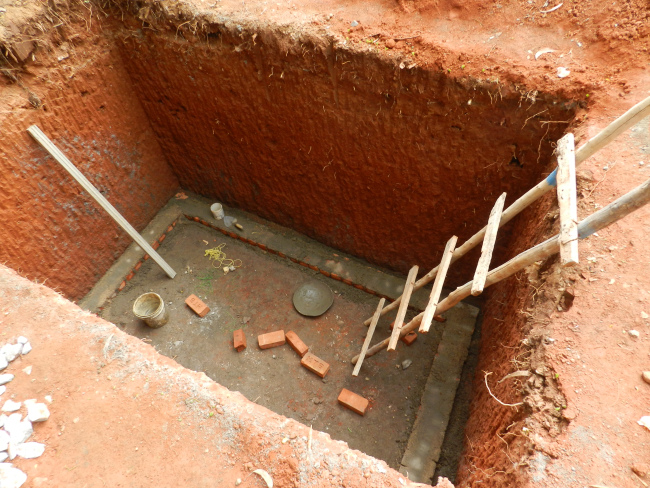

A sump is an underground (or partially underground) tank that is popular in India. It is usually used for large water tank storage and can be built cheaply using cement-like materials. It is usually part of a rainwater harvesting system, where the rainwater gets channeled into the tank, then pumped out for use.
Contents
Suitable conditions
The ground should not be rocky close to the surface, which can hinder the digging and construction process. Secondly the groundwater table in the area should not be very high and should ideally be several metres below the bottom of the tank. Underground sump tanks must not be built very close to underground sewerage chambers or lines trees like the coconut which have strong roots that spread widely existing foundations, especially those that may not be very deep waste water treatment systems.
| Advantages | Disadvantages |
|---|---|
| - Generally cheaper than above ground storage tanks - Water cannot leak out through an open tap |
- Construction is time consuming - Can affect the foundation of the building if constructed very close to the building |
Construction, operation and maintenance
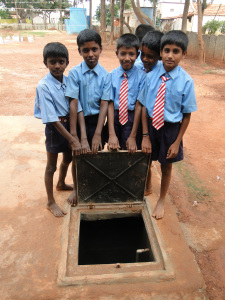
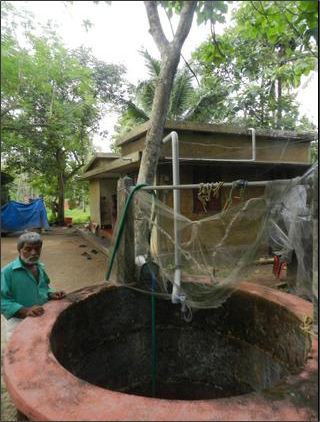
- The overflow pipe should be just below the tank / sump cover so that there is no ‘dead space’ and the tank can be used to its maximum capacity. The overflow pipe should divert the excess water away from the sump and the foundations of other buildings and structures. This water should be directed to gardens or into the storm water drain and should not create slushy areas. A reverse U bend should be installed at the end of the overflow pipe so that light and other impurities do not enter the tank.
- Water should be extracted from the tank / sump only by means of a tap or pump. Taps or draw off pipes should not be very close to the bottom of the tank, since there is likelihood of sedimentation and the dirt should be allowed to settle and remain in the tank until cleaned. If the dirt enters the water outlet pipe and the plumbing network it can cause blockages.
- Sumps could have level indicators, so that the pumps don’t run dry. Level indicators can be as simple as a dip-stick or can be electronic. Dip-stick systems have the disadvantage of being a conduit for light and impurities to enter the storage tank
- How large should the sump be? Even a small storage system can generate large collection provided we use the rainwater every time it rains. In Bangalore for example, with it’s evenly spread rains, a 500 litre sump tank can generate 25,000 litres of rainwater in a year. An ideal size is 2000 litres of sump storage for 100 square metre of roof area. This is as per the building bye law for Bangalore. 6000 litres of storage for 100 square metre roof area should give you 70,000 litres of water in a well distributed rainfall year1.
- Cylindrical ferrocement or Reinforced Cement Concrete (RCC) recommended as tank building material. Plastic or brick is not recommended.
- A first rain separator is crucial to the collection of clean rainwater in sump tanks2.
Bangalore example
In Bangalore, water will be purchased from private water tankers and stored to be used for construction. One estimate says there a million sumps in the city alone with an average capacity of 6000 litres. This means that the water storage capacity created is a staggering 6000 million litres. Remember that the city gets in about 1000 million litres every day. Added to the fact that there is about 1000 million litres stored in overhead tanks the water storage by the city far outstrips that created by the utility.
Once the construction is completed the very same sump tank will be used to store the intermittent supply from the water utility. From here a pump will send it to the overhead tank to be reticulated by gravity to all the water points in the building.
Usually the sump tank is located in the North East corner of the site, especially for those who believe in Vaastu. The overhead tank is located in the South West for that is supposed to be the highest point of a building. Beliefs aside there are many technical things that should be carefully thought through to ensure that the sump delivers efficiently what it is supposed to.
The sump should be based on firm earth and with a good bed concrete. If the soil below is clayey or non-homogeneous it is better to build a RCC raft slab below. The side walls should not be compromised on and should be with good brick work using a nine inch wall. Alternately concrete blocks or hollow concrete blocks of good quality can be used. In high water table areas or areas of loose soil both sides of the wall should be plastered. The inside of the sump tank wall should be plastered with a waterproof compound on a wire mesh base. This will ensure that the sump tank does not leak. After it is built the tank should be filled with water and checked that there is no leak. Any leak should be detected and fixed immediately.
Sump tanks are extremely unsafe spots on a site especially for children of construction workers and for others. They should immediately have a cover slab cast with an inspection cover securely locked. The sump cover should be rust proof. Aluminum covers are now available which are excellent.
The other things to remember are to use a submersible pump which is energy efficient. The submersible pump will save space being inside the sump. The pipeline from the sump to the overhead tank should be as straight as possible and with as few bends as possible. PVC or GI pipes of the right gauge and size should be used.
A ball valve regulates the water intake into the sump. This should be of good quality and should function effectively. In Bangalore the sump can also double up as a rainwater harvesting structure thus being multi-purpose in use. During the rains rainwater and during the non-rainy season water from other sources can be stored.
While digging in most places in the city good red earth will be obtained. This can be used for gardening and even for the making of earth blocks for the building.
An annual cleaning and maintenance is recommended preferably without wasting the water inside it. During summer and during water borne disease outbreaks it is best to dose the sump water with bleaching powder and to measure the residual chlorine as 2 mg per litre after about 4 hours of the dosing. This will keep waterborne infections like cholera at bay.
Even though hidden from view the sump tank has an important role to play in the use of a building. A good design and maintenance will help extend its life and for it to perform optimally. In this understanding lies water wisdom.
The ideal system in Bangalore is one where rainwater is stored in sumps and the surplus used for recharging borewells.
Field experiences
 Rainwater harvesting for Vijayapura schools |
Costs
A tanker load (in Bangalore) of 6000 litres costing about Rs 200/-. To store water during construction, sumps were built and these would also be 6000 litres so as to fill up a tanker load completely. Coincidentally this happened to be the exact optimal storage requirement for rainwater harvesting. This made it easier for implementation using the sump as storage3.
Manuals, videos and links
References
- ↑ S.Vishwanath
- ↑ S.Vishwanath
- ↑ Domestic Rainwater Harvesting, Some applications in Bangalore, India
Acknowledgements
- On the sump tanks of Bangalore. October 31, 2013.
- Chapter 6 - Storage Tank. Schools.indiawaterportal.org.
